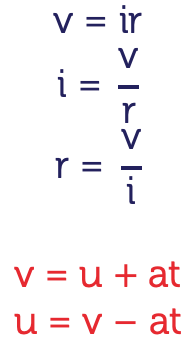A formula is a general rule giving the relationship between variables. The variables are represented by letters which provide us with a short hand way of writing the rule. Sometimes a formula is given in an inconvenient form and it's necessary to change the subject of the formula. When we do this we need to use certain operations, so remember the following rules; minus undoes plus, plus undoes minus, division undoes multiplication, multiplication undoes division, square root undoes square and square undoes square root.
Let's look at some examples to explain this. Let's look at the formula A plus B equals C. Now let's make A the subject, because we want to obtain A on its own we start by subtracting B so let's use the rule minus undoes plus, so we have A plus B minus B equals C minus B, so from this we obtained A equals C minus B. Note we have to use minus B on both sides of the equation, remember the saying what we do to one side of the equation we must do to the other side of the equation so we have transposed the formula to find an expression for A.
Let's look at another example. We have X minus Y equals Z and we want to make Y the subject. Notice we have a minus Y so let's use the rule plus undoes minus, we write X minus Y plus Y equals Z plus Y. Note we have used plus Y on both sides of the equation so this leaves us with X equals Z plus Y, but we want Y on its own so we use the rule minus undoes plus again to get rid of Z so we have X minus Z equals Z minus Z plus Y which leaves us with X minus Z equals Y or rewriting that with Y on the left hand side we have Y equals X minus Z.
Let's look at the formula for the area of a rectangle. The area of a rectangle is A equals L times W where A is the area, L is the length and W is the width of the rectangle. We say that A is the subject of the formula, let's say we want to find the width, W, so we use the rule division undoes multiplication by dividing both sides by L. So let's do that. We divide the left hand side by L, which is A over L and we divide the right hand side by L, so it's L times W over L. So A over L is equal to W, notice that the Ls have cancelled out on the right hand side. If we swap the left hand side and the right hand side we have W equals A divided by L.
Let's look at the formula M equals Q over P. M is the magnification of an object, Q is the size of the image and P is the size of the object. We want to find Q, the image size, so let's use the rule multiplication undoes division, so if we multiply both sides by P we get M times P equals Q over P multiplied by P and this leaves us with M times P equals Q and so if we swap both left hand side and right hand side we get Q equals M times P.
That completes the film clip of transposition of formulas. Now go to the worksheet and try some exercises for yourself. Thank you.



